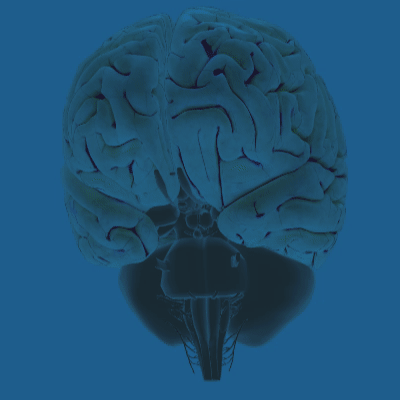Getting to the Root of Migraines
- Published23 Apr 2021
- Author Alexis Wnuk
- Source BrainFacts/SfN

As a young medical resident in the 1970s, Michael Moskowitz wanted to do more for his migraine patients. The treatment available at the time — a drug called ergotamine — didn’t help everyone and had serious side effects like nausea, vomiting, muscle cramps, dizziness, and numbness and tingling in the limbs. “I realized how ineffective the treatment was and how disabling the treatment was,” he says. So, he turned to the science of migraine. At the time, the field was focused on the blood vessels in and around the brain. The going theory was that something circulating in the blood caused the vessels to dilate, which caused pain.
To Moskowitz, this explanation didn’t add up. Most migraines are isolated to one side of the head. Both sides of the head get the same blood, so why would only one side get the headache? Moskowitz shifted his attention to the trigeminal nerve, the major nerve transmitting all kinds of sensation from the head, including pain.
Later, other researchers in Europe and Australia would similarly question the prevailing wisdom of migraine. Lars Edvinsson, Peter Goadsby, and Jes Olesen, along with Moskowitz, forged a new path, and, over the next 40 years, they unraveled the biology of migraine bit by bit. Their discoveries catalyzed the development of new drugs to treat and prevent migraine and earned them the 2021 Brain Prize.
BrainFacts.org spoke to them about their work and the next big challenges for migraine researchers.
What is a migraine and how is it different from a regular headache?
Migraine headaches are often more severe than regular headaches. The characteristic throbbing pain usually begins on one side of the head. People may also experience extreme sensitivity to light and sound as well as nausea and vomiting. Migraine attacks can last anywhere from a few hours to three days, and most people experience one or two attacks per month. “These are really a different kind of headache that can actually be debilitating and disabling and disruptive to life and family,” says Moskowitz, a professor of neurology at Harvard Medical School.
For some people, sensory disturbances called auras precede the pain of a migraine attack. These usually involve temporary changes in vision like blind spots, flashing lights, or zig zag lines that slowly float across the visual field.
Worldwide, more than 1 billion people experience migraine — or roughly 1 in 7 people. Migraine affects twice as many women as men. Plus, emerging evidence suggests women experience more severe migraine attacks and are more disabled by them, says Jes Olesen, a professor of neurology at the University of Copenhagen and chief physician at the Danish Headache Center. “So if you look at some kind of composite evaluation of the [disease] burden it’s more like 5 to 1.”
How was the brain’s role in migraine discovered?
The first piece of the puzzle fell into place in the early 1980s when Moskowitz discovered the link between the trigeminal nerve and the blood vessels in the meninges. The vessels are one of the few pain-sensitive structures in the cranium. But, scientists didn’t know which nerves carried that pain signal to the brain. To figure that out, Moskowitz used a technique called used retrograde axonal tracing where fluorescent molecules placed neuron the ends of nerve fibers are taken up by the neurons and transported back to the cell body. Shine a light and you can see where those molecules wind up.
The results of the experiment confirmed his suspicion: the nerve fibers wrapped around the blood vessels were part of the trigeminal nerve. Additional experiments showed that the trigeminal nerve released neuropeptides — small proteins that act as signaling molecules — that could dilate blood vessels and cause pain.
Lars Edvinsson became interested in one of these peptides, calcitonin gene-related peptide, or CGRP. In a series of studies in the early 80s, he discovered the trigeminal nerve fibers wrapped around cranial blood vessels contained CGRP and that the peptide could dilate the vessels, making it a prime suspect for migraine.
In 1988, he began a collaboration with Peter Goadsby, and the pair identified CGRP as the key peptide in migraine. In a pivotal study published in 1990, they measured the blood levels of various neuropeptides in people experiencing during a migraine attack. Participants came to the emergency department of an Australian hospital complaining of migraine symptoms and consented to two blood draws: They took two blood samples: one from the forearm and one from the jugular vein in the neck. The forearm sample measured peptides circulating throughout the body, while the blood extracted from the jugular vein homed in on peptides in the cerebral blood flow. Of all neuropeptides catalogued, only CGRP was elevated in the cerebral blood flow. What’s more, the migraine patients had twice as much of this peptide compared to a group of control subjects. “That was, I think, when we felt we were really onto something,” says Goadsby, now a professor of neurology at the University of California Los Angeles.
But did CGRP cause migraine or was it just a consequence of a migraine attack? Jes Olesen endeavored to find out. In previous studies, he used an imaging technique called single photon emission tomography to photograph blood flow in the brain during an aura. It turned out the dye that made the arteries visible just happened to trigger an aura about an hour later, which meant he could see how blood flow changed leading up to an aura. The experiments debunked the prevailing theory that reduced blood flow triggered the aura. They also opened new avenues for studying migraine.
“It was the first experience which also told me that … to trigger attacks is maybe the way to understand migraine,” Olesen says. He led a series of studies where he injected various substances into volunteers’ arms in the hopes of triggering a migraine. In 2002, he published a study showing that CGRP triggered migraine attacks in migraine patients, suggesting a causative role for the peptide.
How did these discoveries lead to new treatments for migraine?
“If you can induce a migraine attack, there’s a good chance that blocking that mechanism could also treat a migraine attack,” Olesen says. In a 2004 study, Olesen and an international team of collaborators that included Goadsby showed a drug that blocked neuronal receptors for CGRP could treat acute migraine attacks. While the drug never made its way to pharmacy shelves because it could only be administered intravenously, it was a proof of concept for CGRP blockers.
The pharmaceutical industry took note and began developing drugs to block CGRP receptors. Edvinsson and his colleagues tested the effects of these drugs and participated in clinical trials. In 2019, the U.S. Food and Drug Administration approved ubrogepant, the first oral CGRP antagonist for the treatment of migraine, developed by the pharmaceutical company Allergan. Other pharmaceutical companies went a different route, devising lab-made “immune molecules” targeting CGRP and its receptors. Three of these therapies — called monoclonal antibodies — are now FDA approved for the prevention of migraine. The once-monthly injections reduce patients’ migraine days, sometimes by as much as one-half.
What are the next big mysteries to solve in migraine research?
Edvinsson wants to know why migraines affect twice as many women as men. It turns out that trigeminal nerve fibers contain receptors for estrogen and oxytocin in addition to CGRP. Levels of the hormones drop just before menstruation; this drop may somehow excite the trigeminal system, says Edvinsson, a professor of internal medicine at Lund University in Sweden. His team is working out the details but says that’s their next frontier.
Pinning down how a migraine attack starts is another vexing problem. “If you’re a curious neurobiologist, you want to know the whys,” Edvinsson says. “I think this will teach us a lot … about brain function.”
Goadsby is more motivated by his patients. “I think understanding how the attack gets started offers two things,” he says. “One, it offers a way to treat people before the horse has bolted, so to speak. And two, if you understand how something really gets started, then you’ve got a link into what the biology of stopping it is.”
References
Goadsby, P. J., & Edvinsson, L. (1993). The trigeminovascular system and migraine: Studies characterizing cerebrovascular and neuropeptide changes seen in humans and cats. Annals of Neurology, 33(1), 48–56. https://doi.org/10.1002/ana.410330109
Goadsby, P. J., Edvinsson, L., & Ekman, R. (1988). Release of vasoactive peptides in the extracerebral circulation of humans and the cat during activation of the trigeminovascular system. Annals of Neurology, 23(2), 193–196. https://doi.org/10.1002/ana.410230214
Goadsby, P. J., Edvinsson, L., & Ekman, R. (1990). Vasoactive peptide release in the extracerebral circulation of humans during migraine headache. Annals of Neurology, 28(2), 183–187. https://doi.org/10.1002/ana.410280213
Lassen, L., Haderslev, P., Jacobsen, V., Iversen, H., Sperling, B., & Olesen, J. (2002). Cgrp May Play A Causative Role in Migraine. Cephalalgia, 22(1), 54–61. https://doi.org/10.1046/j.1468-2982.2002.00310.x
Mayberg, M., Langer, R. S., Zervas, N. T., & Moskowitz, M. A. (1981). Perivascular meningeal projections from cat trigeminal ganglia: Possible pathway for vascular headaches in man. Science (New York, N.Y.), 213(4504), 228–230. https://doi.org/10.1126/science.6166046
Moskowitz, M. A., Reinhard, J. F., Romero, J., Melamed, E., & Pettibone, D. J. (1979). Neurotransmitters and the fifth cranial nerve: Is there a relation to the headache phase of migraine? The Lancet, 2(8148), 883–885. https://doi.org/10.1016/s0140-6736(79)92692-8
Olesen, J., Diener, H.-C., Husstedt, I. W., Goadsby, P. J., Hall, D., Meier, U., Pollentier, S., & Lesko, L. M. (2004). Calcitonin Gene–Related Peptide Receptor Antagonist BIBN 4096 BS for the Acute Treatment of Migraine. New England Journal of Medicine, 350(11), 1104–1110. https://doi.org/10.1056/NEJMoa030505
Tfelt-Hansen, P., Saxena, P. R., Dahlöf, C., Pascual, J., Láinez, M., Henry, P., Diener, H.-C., Schoenen, J., Ferrari, M. D., & Goadsby, P. J. (2000). Ergotamine in the acute treatment of migraine: A review and European consensus. Brain, 123(1), 9–18. https://doi.org/10.1093/brain/123.1.9
Uddman, R., Edvinsson, L., Ekman, R., Kingman, T., & McCulloch, J. (1985). Innervation of the feline cerebral vasculature by nerve fibers containing calcitonin gene-related peptide: Trigeminal origin and co-existence with substance P. Neuroscience Letters, 62(1), 131–136. https://doi.org/10.1016/0304-3940(85)90296-4
BrainFacts.org welcomes all your brain-related questions.
Every month, we choose one reader question and get an answer from a top neuroscientist. Always been curious about something?








